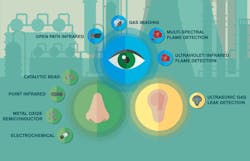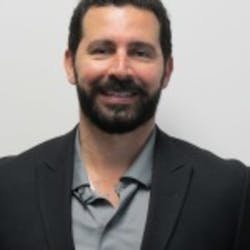Ardem Antabian holds dual bachelor of science degrees in chemical engineering and chemistry. He started his career in the fixed gas and flame detection industry in 1999 and has been in various positions throughout the global organization of General Monitors, including assignments in Dubai, UAE, and Berlin, Germany. He was involved in the development of General Monitors’ new point infrared (IR) gas detector, open path IR gas detector, and multispectral IR flame detector. He is now General Monitors’ OGP Segment marketing manager.
Q: According to the Center for Effective Government, there have been 400 chemical accidents in the U.S. since August 2013. In your opinion, why do chemical accidents persist despite recent efforts to improve chemical safety policy?
A: Most accidents, unfortunately, are due to human error. For this reason in the fixed gas and flame detection industry, we have designed our safety systems to monitor facilities with little-to-no human interaction. The gas and flame detectors are designed with intelligence within each unit. The detectors work independently or together to alarm when a flame or gas leak is detected. The detectors are typically connected to a programmable logic controller (PLC) to collect data from the detectors and report locally, or via a centralized distributed control system (DCS). Based on my global experience visiting many petrochemical facilities, the more education we provide to workers within facilities, the safer they become.
Q: What makes gas and fire safety such a challenging issue in industrial facilities?
A: One of the biggest challenges in the fixed gas and flame industry is customer education. We as experts stretch ourselves to connect with petrochemical facility managers, engineers and technicians to provide the best available technologies and share the best safety monitoring implementation practices. The more knowledgeable a user of detection systems becomes, the safer the overall system and facility. We are now utilizing communication technologies such as video conferencing, white papers, and tech-focused animations to educate the overall safety industry.
Q: How has sensing technology traditionally fallen short in the area of gas and flame protection in industrial facilities?
A: Traditional gas and flame detectors were safe, but could cause false alarms. Over the past decades, we have achieved advances in flame and gas sensing technologies to provide a high level of immunity to false alarms. Avoiding false alarms is important because they result in unnecessary process or plant shutdowns, slowing production and requiring time-consuming reviews, paperwork, and reporting. False alarms can, over time, provide employees with a false sense of security because they become complacent if alarms go off for no apparent reason and then just choose to ignore them. The trouble is that you can’t really determine by yourself the difference between a false alarm and a serious accident about to happen.
Q: How is modern sensing technology evolving to better address the chemical and fire safety issue?
A: We have developed new technologies such as open-path infrared and ultrasonic gas leak detectors, which are now used with traditional detectors as layers of protection to increase safety at petrochemical facilities. By combining the traditional detectors with newer technologies, we create layers of detection and protection. Together these detection layers monitor the overall facility, not only to increase reliability and safety but also to lower the overall cost related to the gas and flame detection system.
Q: What is the "human sensory" approach to gas and flame detection, and how is it an improvement over traditional sensing methods?
A: When you think about today’s gas and flame detection sensing technologies, they mimic the senses of the people who invented them. Catalytic bead detectors "sniff" gases for example, infrared and optical type sensors "see" gases and flames, and ultrasonic sensors "hear" gases. So, the human sensory approach is very much technology-focused. We developed this system to help facility managers, engineers and technicians better understand how each technology is applied and works to make their facilities even safer. The traditional approach was guesswork based on past experience and usage. The human sensory model brings to light the strengths and weaknesses in each technology. By understanding each technology and implementing layers of protection, one can increase coverage and safety.
Q: How do Artificial Neural Networks relate to modern gas and flame detection systems?
A: We implemented ANN as "NNT" (Neural Network Technology) when developing our multi-spectral IR (MSIR) flame detector over 10 years ago. The MSIR flame detector uses an array of IR sensors to monitor unwanted fires. The MSIR flame detector’s NNT intelligence quickly processes the multitude of data points available to determine if there is an actual fire in the facility.
Questions for this interview were provided by Matt Migliore, Flow Control’s director of content. Matt can be reached at [email protected].



